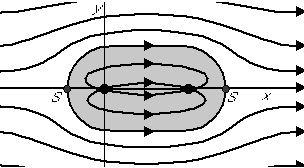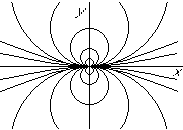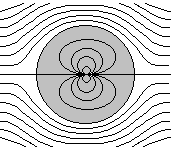
(Book 18.5, 6; 20.19)
We can create a finite body by placing a sink a distance e behind the source to absorb its fluid:

![]()
If we let the sink and the source approach each other, ![]() , while at the same time increasing their strength m, the body
shape becomes circular:
, while at the same time increasing their strength m, the body
shape becomes circular:
![]()
![]()
The second term is of the form
![]()

Changing the name of the constant once more, the potential for transverse flow past a circular cylinder becomes:


Exercise:
Show that this is indeed flow past a circular cylinder and that the radius of the cylinder is r0.
Exercise:
Assume that a cylinder of radius r0=1 moves along the x-axis through an incompressible, irrotational fluid that is at rest at large distances from the cylinder. The position of the center is given as z0=x0(t). What is the complex velocity potential? (Hint: write the velocity potentialin a coordinate system moving with the cylinder, then substract the coordinate system's translational velocity to find F.)
Exercise:
For the previous exercise, find the pressures along the surface of the cylinder, i.e.,
. Assume that the (gauge) pressure is zero at large distances from the cylinder. Ignore gravity.
Exercise:
To get a drag force, the pressures on the front half of the cylinder must be greater than those on the rear half. When is that the case? For motion at constant velocity, how much drag does the cylinder experience moving through this fluid? How much lift?
The derived solution only applies for short times after the flow is started by a gust of air or wind. After the air has moved a distance of about a diameter, the thin boundary layer around the cylinder breaks up:
http://www.eng.famu.fsu.edu/
![]() dommelen/research/ini2d/ini2dana.html
dommelen/research/ini2d/ini2dana.html
Pictures at the highest Reynolds number that can (hopefully) be computed accurately with current technology are at:
http://www.eng.famu.fsu.edu/
![]() dommelen/research/cylinder/cylinder.html
dommelen/research/cylinder/cylinder.html
The boundary-layer break-up, or ``separation'' eventually leads to the formation of a large wake behind the cylinder. The streamlines outside the boundary layer and wake no longer follow the rear shape of the cylinder and the complex potential U (z+ r02/z) is no longer valid.
The same separation process occurs on subsonic wings of aircraft if the aircraft flies at too large an angle of attack (in other words, too slow:)
http://www.eng.famu.fsu.edu/
![]() dommelen/research/airfoil/airfoil.html
dommelen/research/airfoil/airfoil.html
Finally, no, the complex streamfunction solution does not apply to flow at very low Reynolds numbers, even though the streamlines look superficially the same:
Exercise:
Find the fluid velocity at the surface of the cylinder and thus establish that the complex potential U (z+ r02/z) needs a thin boundary layer at the wall to satisfy no-slip.
You should now be able to do 18.5